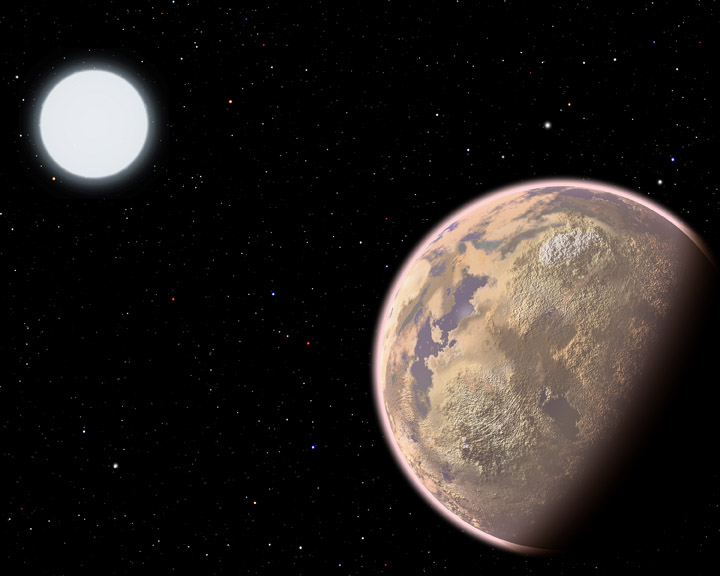A new approach to SETI: targeting alien polluters
July 24, 2014

In this artist’s conception, the atmosphere of an Earth-like planet displays a brownish haze from widespread pollution. New research shows that the upcoming James Webb Space Telescope potentially could detect certain pollutants, specifically CFCs, in the atmospheres of Earth-sized planets orbiting white dwarf stars. (Credit: Christine Pulliam (CfA))
We might be able to spot extraterrestrial civilizations if we assume they spew industrial pollution into the atmosphere, say theorists at the Harvard-Smithsonian Center for Astrophysics (CfA).
Conversely, ET could spot us.
The team suggests that under ideal conditions, the upcoming James Webb Space Telescope (JWST) should be able to detect two kinds of chlorofluorocarbons (CFCs) — aerosols and ozone-destroying chemicals used in solvents.
They calculated that JWST could tease out the signal of CFCs if atmospheric levels were 10 times those on Earth. A particularly advanced civilization might also intentionally pollute the atmosphere to high levels and globally warm a planet that is otherwise too cold for life.
However, JWST can only detect pollutants on an Earth-like planet circling a white dwarf star, which is what remains when a star like our Sun dies. That scenario would maximize the atmospheric signal/noise. Finding pollution on an Earth-like planet orbiting a Sun-like star would require an instrument beyond JWST — a next-next-generation telescope.
The team notes that a white dwarf might be a better place to look for life than previously thought, since recent observations found planets in similar environments. Those planets could have survived the bloating of a dying star during its red giant phase, or have formed from the material shed during the star’s death throes.
While searching for CFCs could ferret out an existing alien civilization, it also could detect the remnants of a civilization that annihilated itself. Some pollutants last for 50,000 years in Earth’s atmosphere while others last only 10 years. Detecting molecules from the long-lived category but none in the short-lived category would show that the sources are gone.
“In that case, we could speculate that the aliens wised up and cleaned up their act. Or in a darker scenario, it would serve as a warning sign of the dangers of not being good stewards of our own planet,” says Harvard co-author Avi Loeb.
This work has been accepted for publication in The Astrophysical Journal . An open-access arXiv version is available online.
Abstract of arXiv paper
Detecting biosignatures, such as molecular oxygen in combination with a reducing gas, in the atmospheres of transiting exoplanets has been a major focus in the search for alien life. We point out that in addition to these generic indicators, anthropogenic pollution could be used as a novel biosignature for intelligent life. To this end, we identify pollutants in the Earth’s atmosphere that have significant absorption features in the spectral range covered by the James Webb Space Telescope (JWST). We focus on tetrafluoromethane CF4 and trichlorofluoromethane (CCl3F), which are the easiest to detect chlorofluorocarbons (CFCs) produced by anthropogenic activity. We estimate that ~1.2 days (~1.7 days) of total integration time will be sufficient to detect or constrain the concentration of CCl3F (CF4) to ~10 times current terrestrial level.